A Research Proposal: Employee Engagement's Role in Tesco's Success
VerifiedAdded on 2023/06/06
|13
|3853
|222
Report
AI Summary
This research proposal investigates the impact of employee engagement on Tesco's financial performance within the UK retail sector. It aims to understand employee engagement concepts, analyze factors affecting engagement, identify effective engagement strategies, ascertain the relationship between engagement and business performance, and suggest optimal strategies for employee contribution. The proposal reviews literature highlighting the importance of employee engagement for motivation, productivity, and retention, while also addressing factors such as attitude, management, health, and technology. It references Tesco's implementation of communication channels and colleague engagement programs. The research methodology will define the specific techniques that help in the identification and choosing a way to explain how a research is conducted about a topic.

RESEARCH PROPOSAL
Paraphrase This Document
Need a fresh take? Get an instant paraphrase of this document with our AI Paraphraser

TABLE OF CONTENT
INTRODUCTION ..........................................................................................................................2
MAIN BODY...................................................................................................................................3
CONCLUSION................................................................................................................................3
REFERENCES................................................................................................................................4
INTRODUCTION ..........................................................................................................................2
MAIN BODY...................................................................................................................................3
CONCLUSION................................................................................................................................3
REFERENCES................................................................................................................................4
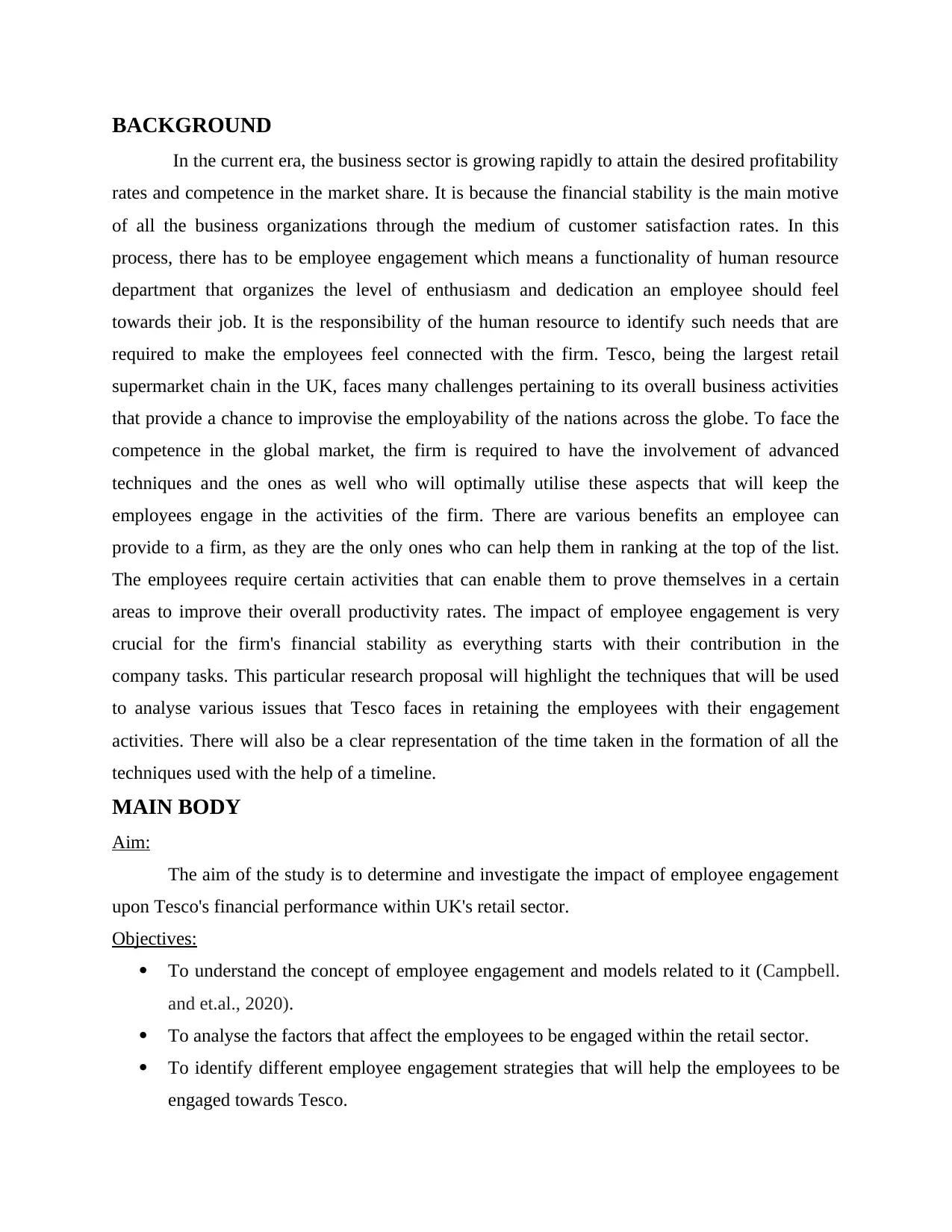
BACKGROUND
In the current era, the business sector is growing rapidly to attain the desired profitability
rates and competence in the market share. It is because the financial stability is the main motive
of all the business organizations through the medium of customer satisfaction rates. In this
process, there has to be employee engagement which means a functionality of human resource
department that organizes the level of enthusiasm and dedication an employee should feel
towards their job. It is the responsibility of the human resource to identify such needs that are
required to make the employees feel connected with the firm. Tesco, being the largest retail
supermarket chain in the UK, faces many challenges pertaining to its overall business activities
that provide a chance to improvise the employability of the nations across the globe. To face the
competence in the global market, the firm is required to have the involvement of advanced
techniques and the ones as well who will optimally utilise these aspects that will keep the
employees engage in the activities of the firm. There are various benefits an employee can
provide to a firm, as they are the only ones who can help them in ranking at the top of the list.
The employees require certain activities that can enable them to prove themselves in a certain
areas to improve their overall productivity rates. The impact of employee engagement is very
crucial for the firm's financial stability as everything starts with their contribution in the
company tasks. This particular research proposal will highlight the techniques that will be used
to analyse various issues that Tesco faces in retaining the employees with their engagement
activities. There will also be a clear representation of the time taken in the formation of all the
techniques used with the help of a timeline.
MAIN BODY
Aim:
The aim of the study is to determine and investigate the impact of employee engagement
upon Tesco's financial performance within UK's retail sector.
Objectives:
To understand the concept of employee engagement and models related to it (Campbell.
and et.al., 2020).
To analyse the factors that affect the employees to be engaged within the retail sector.
To identify different employee engagement strategies that will help the employees to be
engaged towards Tesco.
In the current era, the business sector is growing rapidly to attain the desired profitability
rates and competence in the market share. It is because the financial stability is the main motive
of all the business organizations through the medium of customer satisfaction rates. In this
process, there has to be employee engagement which means a functionality of human resource
department that organizes the level of enthusiasm and dedication an employee should feel
towards their job. It is the responsibility of the human resource to identify such needs that are
required to make the employees feel connected with the firm. Tesco, being the largest retail
supermarket chain in the UK, faces many challenges pertaining to its overall business activities
that provide a chance to improvise the employability of the nations across the globe. To face the
competence in the global market, the firm is required to have the involvement of advanced
techniques and the ones as well who will optimally utilise these aspects that will keep the
employees engage in the activities of the firm. There are various benefits an employee can
provide to a firm, as they are the only ones who can help them in ranking at the top of the list.
The employees require certain activities that can enable them to prove themselves in a certain
areas to improve their overall productivity rates. The impact of employee engagement is very
crucial for the firm's financial stability as everything starts with their contribution in the
company tasks. This particular research proposal will highlight the techniques that will be used
to analyse various issues that Tesco faces in retaining the employees with their engagement
activities. There will also be a clear representation of the time taken in the formation of all the
techniques used with the help of a timeline.
MAIN BODY
Aim:
The aim of the study is to determine and investigate the impact of employee engagement
upon Tesco's financial performance within UK's retail sector.
Objectives:
To understand the concept of employee engagement and models related to it (Campbell.
and et.al., 2020).
To analyse the factors that affect the employees to be engaged within the retail sector.
To identify different employee engagement strategies that will help the employees to be
engaged towards Tesco.
⊘ This is a preview!⊘
Do you want full access?
Subscribe today to unlock all pages.

Trusted by 1+ million students worldwide

To ascertain the relationship between employee engagement and business performance.
To suggest the best strategy that will persuade the employees to contribute effectively in
attaining success rates (Agha. and et.al., 2019).
Research questions:
What is the importance and benefits of employee engagement in an organization?
In what ways does leadership affect the employees in the engaging activities?
How does the relationship between the employees and their supervisors workout?
How do the employees collectively contribute towards the financial stability of the firm.
Rationale
An entity's financial performance mainly depends upon the employee engagement
because they are the ones working in the entity to achieve the goals and objectives. Each and
every strategy and policy comes into effect when there is a workforce working in the
organization. Therefore, knowing the impact of employee engagement on the financial
performance of the Tesco is crucial. This will include understanding the concept of employee
engagement and the related models along with analysing various strategies related to employee
engagement in Tesco. It will also involve ascertaining the relationship between employee and
business performance and will finally include suggestion regarding the application of the best
strategies that will motivate employees in contribution towards attainment towards the success
rates. Through such a research, it will be understood that business having high employee
engagement will be having lower turnover as compared to those having lower employee
engagement.
LITERATURE REVIEW
As per Awadari and Kanwal (2019), when the employees feel motivated and connected
towards the objectives and goals of the organization it is known an optimal employee
engagement. In such a way, they will be working harder, staying longer in the organization, be
motivated and also motivating others to be on the same page of motivation. Thus, it can be said
that this employee engagement will be affecting each and every aspect of any successful
organization like profitability, customer experience, revenue, employee turnover, etc. It has been
proven through researches that almost 92% of the business leaders believes in employee
engagement as it leads to better performance of the employee, the success of the teams is boosted
effectively and the results of the organization are exceptional. Also, Rosnizam and et.al. (2020)
To suggest the best strategy that will persuade the employees to contribute effectively in
attaining success rates (Agha. and et.al., 2019).
Research questions:
What is the importance and benefits of employee engagement in an organization?
In what ways does leadership affect the employees in the engaging activities?
How does the relationship between the employees and their supervisors workout?
How do the employees collectively contribute towards the financial stability of the firm.
Rationale
An entity's financial performance mainly depends upon the employee engagement
because they are the ones working in the entity to achieve the goals and objectives. Each and
every strategy and policy comes into effect when there is a workforce working in the
organization. Therefore, knowing the impact of employee engagement on the financial
performance of the Tesco is crucial. This will include understanding the concept of employee
engagement and the related models along with analysing various strategies related to employee
engagement in Tesco. It will also involve ascertaining the relationship between employee and
business performance and will finally include suggestion regarding the application of the best
strategies that will motivate employees in contribution towards attainment towards the success
rates. Through such a research, it will be understood that business having high employee
engagement will be having lower turnover as compared to those having lower employee
engagement.
LITERATURE REVIEW
As per Awadari and Kanwal (2019), when the employees feel motivated and connected
towards the objectives and goals of the organization it is known an optimal employee
engagement. In such a way, they will be working harder, staying longer in the organization, be
motivated and also motivating others to be on the same page of motivation. Thus, it can be said
that this employee engagement will be affecting each and every aspect of any successful
organization like profitability, customer experience, revenue, employee turnover, etc. It has been
proven through researches that almost 92% of the business leaders believes in employee
engagement as it leads to better performance of the employee, the success of the teams is boosted
effectively and the results of the organization are exceptional. Also, Rosnizam and et.al. (2020)
Paraphrase This Document
Need a fresh take? Get an instant paraphrase of this document with our AI Paraphraser
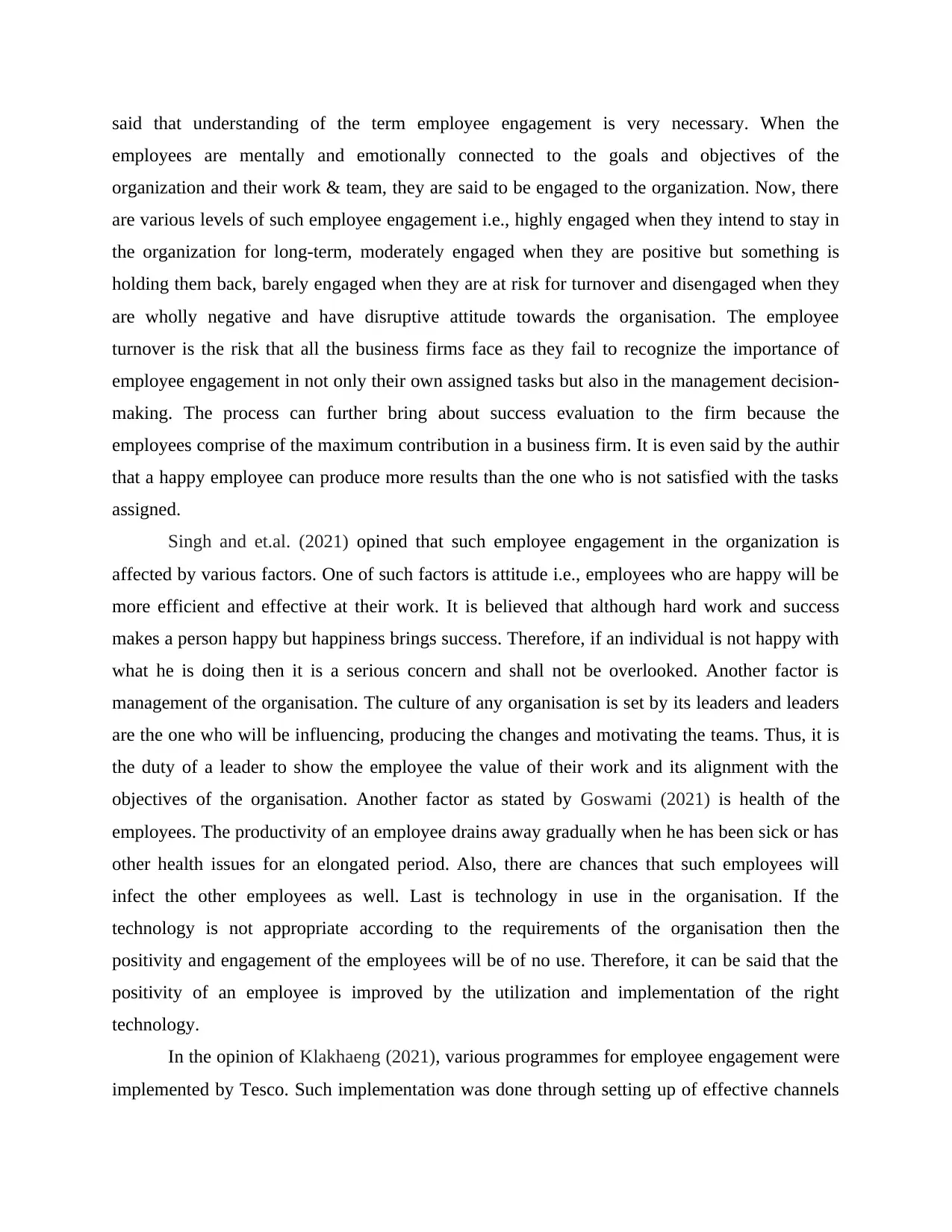
said that understanding of the term employee engagement is very necessary. When the
employees are mentally and emotionally connected to the goals and objectives of the
organization and their work & team, they are said to be engaged to the organization. Now, there
are various levels of such employee engagement i.e., highly engaged when they intend to stay in
the organization for long-term, moderately engaged when they are positive but something is
holding them back, barely engaged when they are at risk for turnover and disengaged when they
are wholly negative and have disruptive attitude towards the organisation. The employee
turnover is the risk that all the business firms face as they fail to recognize the importance of
employee engagement in not only their own assigned tasks but also in the management decision-
making. The process can further bring about success evaluation to the firm because the
employees comprise of the maximum contribution in a business firm. It is even said by the authir
that a happy employee can produce more results than the one who is not satisfied with the tasks
assigned.
Singh and et.al. (2021) opined that such employee engagement in the organization is
affected by various factors. One of such factors is attitude i.e., employees who are happy will be
more efficient and effective at their work. It is believed that although hard work and success
makes a person happy but happiness brings success. Therefore, if an individual is not happy with
what he is doing then it is a serious concern and shall not be overlooked. Another factor is
management of the organisation. The culture of any organisation is set by its leaders and leaders
are the one who will be influencing, producing the changes and motivating the teams. Thus, it is
the duty of a leader to show the employee the value of their work and its alignment with the
objectives of the organisation. Another factor as stated by Goswami (2021) is health of the
employees. The productivity of an employee drains away gradually when he has been sick or has
other health issues for an elongated period. Also, there are chances that such employees will
infect the other employees as well. Last is technology in use in the organisation. If the
technology is not appropriate according to the requirements of the organisation then the
positivity and engagement of the employees will be of no use. Therefore, it can be said that the
positivity of an employee is improved by the utilization and implementation of the right
technology.
In the opinion of Klakhaeng (2021), various programmes for employee engagement were
implemented by Tesco. Such implementation was done through setting up of effective channels
employees are mentally and emotionally connected to the goals and objectives of the
organization and their work & team, they are said to be engaged to the organization. Now, there
are various levels of such employee engagement i.e., highly engaged when they intend to stay in
the organization for long-term, moderately engaged when they are positive but something is
holding them back, barely engaged when they are at risk for turnover and disengaged when they
are wholly negative and have disruptive attitude towards the organisation. The employee
turnover is the risk that all the business firms face as they fail to recognize the importance of
employee engagement in not only their own assigned tasks but also in the management decision-
making. The process can further bring about success evaluation to the firm because the
employees comprise of the maximum contribution in a business firm. It is even said by the authir
that a happy employee can produce more results than the one who is not satisfied with the tasks
assigned.
Singh and et.al. (2021) opined that such employee engagement in the organization is
affected by various factors. One of such factors is attitude i.e., employees who are happy will be
more efficient and effective at their work. It is believed that although hard work and success
makes a person happy but happiness brings success. Therefore, if an individual is not happy with
what he is doing then it is a serious concern and shall not be overlooked. Another factor is
management of the organisation. The culture of any organisation is set by its leaders and leaders
are the one who will be influencing, producing the changes and motivating the teams. Thus, it is
the duty of a leader to show the employee the value of their work and its alignment with the
objectives of the organisation. Another factor as stated by Goswami (2021) is health of the
employees. The productivity of an employee drains away gradually when he has been sick or has
other health issues for an elongated period. Also, there are chances that such employees will
infect the other employees as well. Last is technology in use in the organisation. If the
technology is not appropriate according to the requirements of the organisation then the
positivity and engagement of the employees will be of no use. Therefore, it can be said that the
positivity of an employee is improved by the utilization and implementation of the right
technology.
In the opinion of Klakhaeng (2021), various programmes for employee engagement were
implemented by Tesco. Such implementation was done through setting up of effective channels

of communication like social media platforms, emails, notice boards, etc. Thus, it is clear that
Tesco makes large investments in the resources and environment in which their work and
personal lives are duly supported by the organisation. Such colleague engagement programme
had the objectives to drive the colleague engagement, building and develop a sense of pride
among colleagues, design activities in the organisation which are fun and focussed on business
and impacting colleagues positively along with making them feel inclusive. Also, as per Utama
and et.al. (2022), Tesco utilizes the policy of two-way communication which is also direct. This
involves leaders asking and knowing about the issues and problems faced by the employees and
then acting upon such issues and problems to come to an appropriate solutions and responses.
This can also be referred to as policy of Listen and Fix. Improvements were visible and
witnessed by the employees and they were also communicated with regularly regarding the
business – wide strategies and actions. Such improvements witnessed by the employees were
told by them in their feedbacks that they felt that their work is also important and also they felt
listened by the management.
In the view point of Peeroo (2019), although the primary focus of employee engagement
is on satisfaction, well-being and happiness of the employees but such engagement severely
affects the tangible metrics in any organisation like turnover, profitability, retention, absenteeism
and productivity. An employee who is highly engaged in the organisation will be able to render
greater innovation in his work. This is because mentally satisfied person will work up to his full
potential and will be high productive, dedicated and innovative while working. This will allow
both the organisation as well as the organisation to grow and develop. Also, the productivity of
the highly engaged employee will be high. This is because such employees will be discussing the
projects in hand with their colleagues ore willingly, making connections with others in the entity
and most importantly, spending time in finding solutions to the issues and problems in hand. As
researched by REVI, employee turnover results in large costs to be expended in the form of time
and money. This is because the replacement of an individual in the organisation will result in
costing of a major portion of a worker's annual salary. Staff engagement is difficult to
understand, mainly because it’s an intangible idea that has very real results for a business’s
success. A highly engaged workforce has been shown to improve productivity, increase
profitability and reduce turnover. Having a thorough and thoughtful employee engagement
strategy that is tailored to your staff’s unique needs is crucial to your long-term success. Such
Tesco makes large investments in the resources and environment in which their work and
personal lives are duly supported by the organisation. Such colleague engagement programme
had the objectives to drive the colleague engagement, building and develop a sense of pride
among colleagues, design activities in the organisation which are fun and focussed on business
and impacting colleagues positively along with making them feel inclusive. Also, as per Utama
and et.al. (2022), Tesco utilizes the policy of two-way communication which is also direct. This
involves leaders asking and knowing about the issues and problems faced by the employees and
then acting upon such issues and problems to come to an appropriate solutions and responses.
This can also be referred to as policy of Listen and Fix. Improvements were visible and
witnessed by the employees and they were also communicated with regularly regarding the
business – wide strategies and actions. Such improvements witnessed by the employees were
told by them in their feedbacks that they felt that their work is also important and also they felt
listened by the management.
In the view point of Peeroo (2019), although the primary focus of employee engagement
is on satisfaction, well-being and happiness of the employees but such engagement severely
affects the tangible metrics in any organisation like turnover, profitability, retention, absenteeism
and productivity. An employee who is highly engaged in the organisation will be able to render
greater innovation in his work. This is because mentally satisfied person will work up to his full
potential and will be high productive, dedicated and innovative while working. This will allow
both the organisation as well as the organisation to grow and develop. Also, the productivity of
the highly engaged employee will be high. This is because such employees will be discussing the
projects in hand with their colleagues ore willingly, making connections with others in the entity
and most importantly, spending time in finding solutions to the issues and problems in hand. As
researched by REVI, employee turnover results in large costs to be expended in the form of time
and money. This is because the replacement of an individual in the organisation will result in
costing of a major portion of a worker's annual salary. Staff engagement is difficult to
understand, mainly because it’s an intangible idea that has very real results for a business’s
success. A highly engaged workforce has been shown to improve productivity, increase
profitability and reduce turnover. Having a thorough and thoughtful employee engagement
strategy that is tailored to your staff’s unique needs is crucial to your long-term success. Such
⊘ This is a preview!⊘
Do you want full access?
Subscribe today to unlock all pages.

Trusted by 1+ million students worldwide
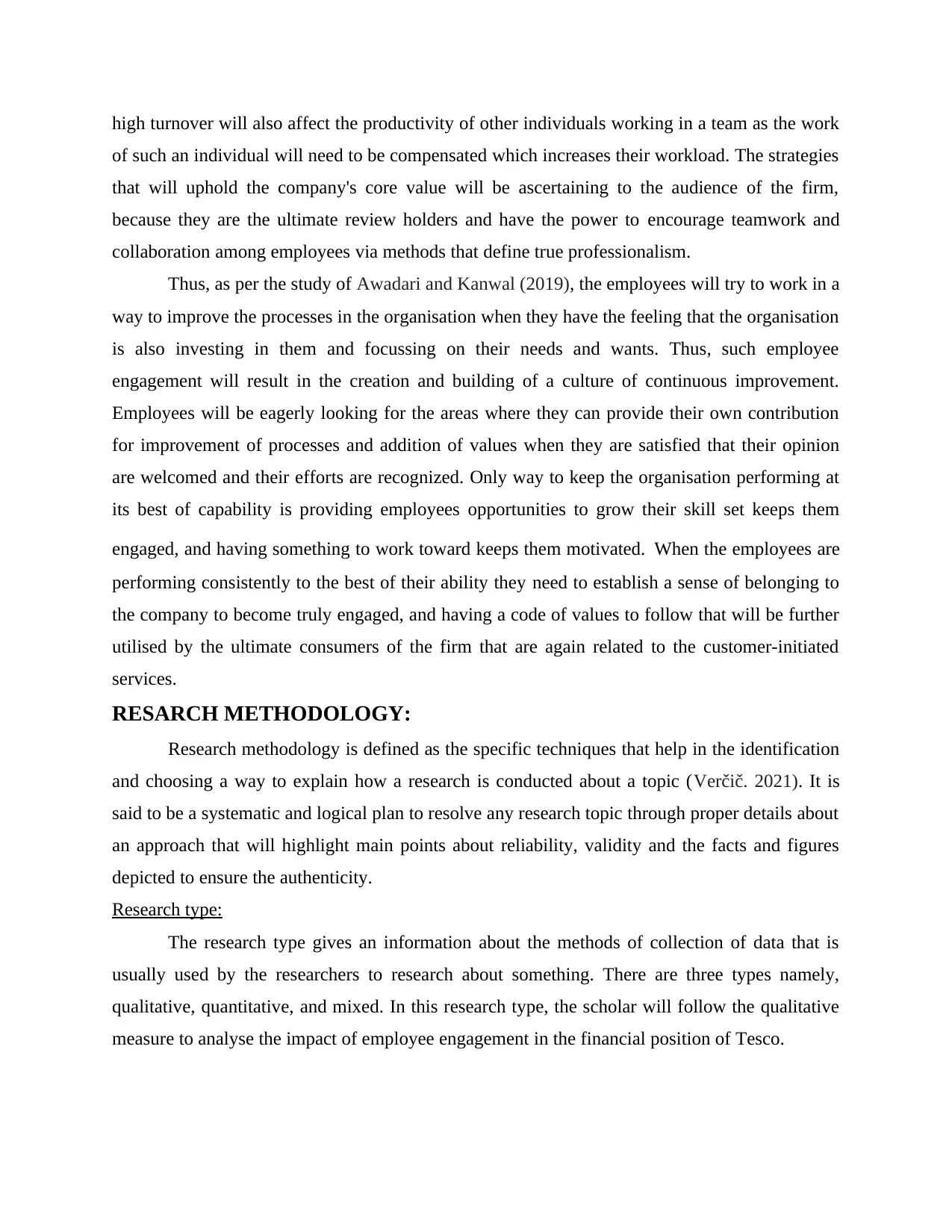
high turnover will also affect the productivity of other individuals working in a team as the work
of such an individual will need to be compensated which increases their workload. The strategies
that will uphold the company's core value will be ascertaining to the audience of the firm,
because they are the ultimate review holders and have the power to encourage teamwork and
collaboration among employees via methods that define true professionalism.
Thus, as per the study of Awadari and Kanwal (2019), the employees will try to work in a
way to improve the processes in the organisation when they have the feeling that the organisation
is also investing in them and focussing on their needs and wants. Thus, such employee
engagement will result in the creation and building of a culture of continuous improvement.
Employees will be eagerly looking for the areas where they can provide their own contribution
for improvement of processes and addition of values when they are satisfied that their opinion
are welcomed and their efforts are recognized. Only way to keep the organisation performing at
its best of capability is providing employees opportunities to grow their skill set keeps them
engaged, and having something to work toward keeps them motivated. When the employees are
performing consistently to the best of their ability they need to establish a sense of belonging to
the company to become truly engaged, and having a code of values to follow that will be further
utilised by the ultimate consumers of the firm that are again related to the customer-initiated
services.
RESARCH METHODOLOGY:
Research methodology is defined as the specific techniques that help in the identification
and choosing a way to explain how a research is conducted about a topic (Verčič. 2021). It is
said to be a systematic and logical plan to resolve any research topic through proper details about
an approach that will highlight main points about reliability, validity and the facts and figures
depicted to ensure the authenticity.
Research type:
The research type gives an information about the methods of collection of data that is
usually used by the researchers to research about something. There are three types namely,
qualitative, quantitative, and mixed. In this research type, the scholar will follow the qualitative
measure to analyse the impact of employee engagement in the financial position of Tesco.
of such an individual will need to be compensated which increases their workload. The strategies
that will uphold the company's core value will be ascertaining to the audience of the firm,
because they are the ultimate review holders and have the power to encourage teamwork and
collaboration among employees via methods that define true professionalism.
Thus, as per the study of Awadari and Kanwal (2019), the employees will try to work in a
way to improve the processes in the organisation when they have the feeling that the organisation
is also investing in them and focussing on their needs and wants. Thus, such employee
engagement will result in the creation and building of a culture of continuous improvement.
Employees will be eagerly looking for the areas where they can provide their own contribution
for improvement of processes and addition of values when they are satisfied that their opinion
are welcomed and their efforts are recognized. Only way to keep the organisation performing at
its best of capability is providing employees opportunities to grow their skill set keeps them
engaged, and having something to work toward keeps them motivated. When the employees are
performing consistently to the best of their ability they need to establish a sense of belonging to
the company to become truly engaged, and having a code of values to follow that will be further
utilised by the ultimate consumers of the firm that are again related to the customer-initiated
services.
RESARCH METHODOLOGY:
Research methodology is defined as the specific techniques that help in the identification
and choosing a way to explain how a research is conducted about a topic (Verčič. 2021). It is
said to be a systematic and logical plan to resolve any research topic through proper details about
an approach that will highlight main points about reliability, validity and the facts and figures
depicted to ensure the authenticity.
Research type:
The research type gives an information about the methods of collection of data that is
usually used by the researchers to research about something. There are three types namely,
qualitative, quantitative, and mixed. In this research type, the scholar will follow the qualitative
measure to analyse the impact of employee engagement in the financial position of Tesco.
Paraphrase This Document
Need a fresh take? Get an instant paraphrase of this document with our AI Paraphraser
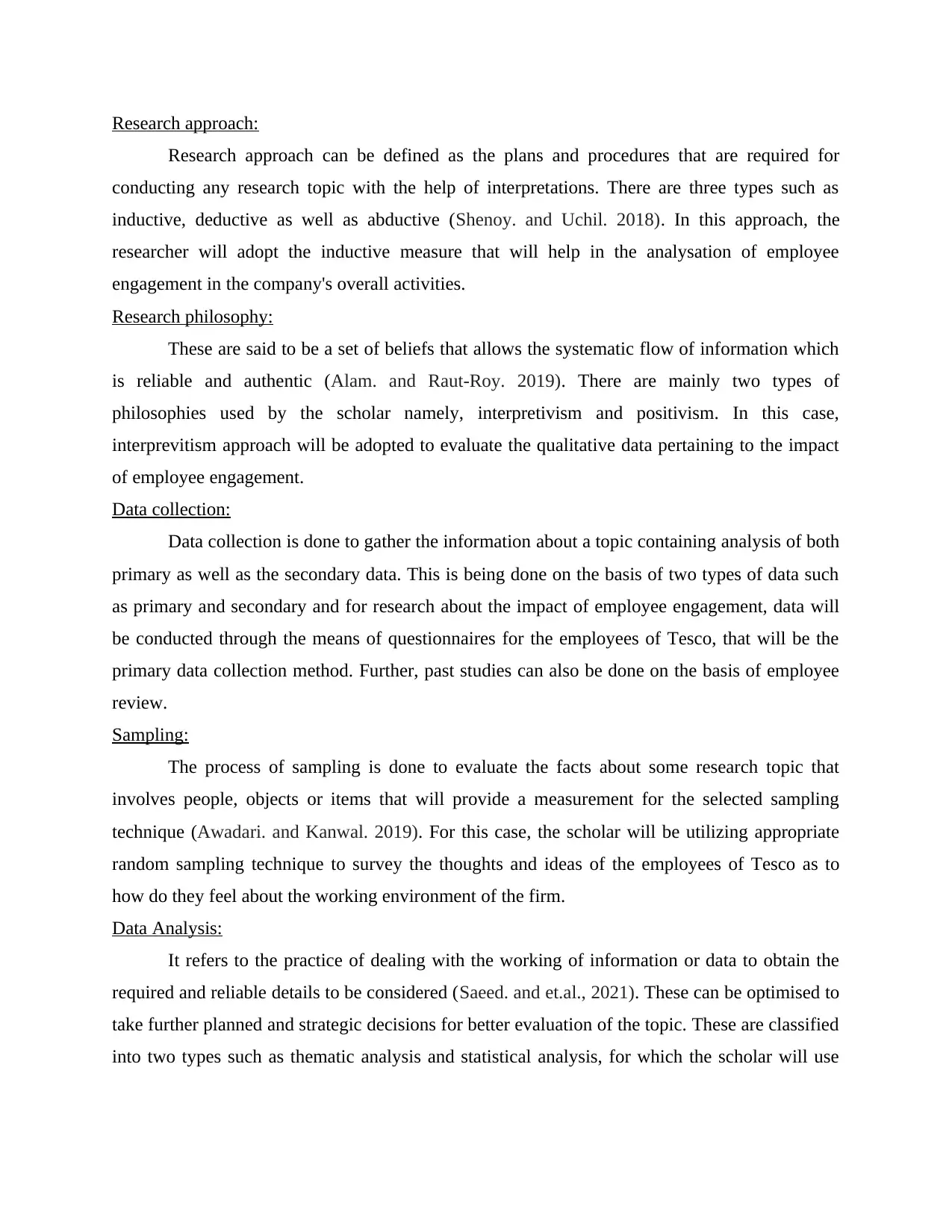
Research approach:
Research approach can be defined as the plans and procedures that are required for
conducting any research topic with the help of interpretations. There are three types such as
inductive, deductive as well as abductive (Shenoy. and Uchil. 2018). In this approach, the
researcher will adopt the inductive measure that will help in the analysation of employee
engagement in the company's overall activities.
Research philosophy:
These are said to be a set of beliefs that allows the systematic flow of information which
is reliable and authentic (Alam. and Raut-Roy. 2019). There are mainly two types of
philosophies used by the scholar namely, interpretivism and positivism. In this case,
interprevitism approach will be adopted to evaluate the qualitative data pertaining to the impact
of employee engagement.
Data collection:
Data collection is done to gather the information about a topic containing analysis of both
primary as well as the secondary data. This is being done on the basis of two types of data such
as primary and secondary and for research about the impact of employee engagement, data will
be conducted through the means of questionnaires for the employees of Tesco, that will be the
primary data collection method. Further, past studies can also be done on the basis of employee
review.
Sampling:
The process of sampling is done to evaluate the facts about some research topic that
involves people, objects or items that will provide a measurement for the selected sampling
technique (Awadari. and Kanwal. 2019). For this case, the scholar will be utilizing appropriate
random sampling technique to survey the thoughts and ideas of the employees of Tesco as to
how do they feel about the working environment of the firm.
Data Analysis:
It refers to the practice of dealing with the working of information or data to obtain the
required and reliable details to be considered (Saeed. and et.al., 2021). These can be optimised to
take further planned and strategic decisions for better evaluation of the topic. These are classified
into two types such as thematic analysis and statistical analysis, for which the scholar will use
Research approach can be defined as the plans and procedures that are required for
conducting any research topic with the help of interpretations. There are three types such as
inductive, deductive as well as abductive (Shenoy. and Uchil. 2018). In this approach, the
researcher will adopt the inductive measure that will help in the analysation of employee
engagement in the company's overall activities.
Research philosophy:
These are said to be a set of beliefs that allows the systematic flow of information which
is reliable and authentic (Alam. and Raut-Roy. 2019). There are mainly two types of
philosophies used by the scholar namely, interpretivism and positivism. In this case,
interprevitism approach will be adopted to evaluate the qualitative data pertaining to the impact
of employee engagement.
Data collection:
Data collection is done to gather the information about a topic containing analysis of both
primary as well as the secondary data. This is being done on the basis of two types of data such
as primary and secondary and for research about the impact of employee engagement, data will
be conducted through the means of questionnaires for the employees of Tesco, that will be the
primary data collection method. Further, past studies can also be done on the basis of employee
review.
Sampling:
The process of sampling is done to evaluate the facts about some research topic that
involves people, objects or items that will provide a measurement for the selected sampling
technique (Awadari. and Kanwal. 2019). For this case, the scholar will be utilizing appropriate
random sampling technique to survey the thoughts and ideas of the employees of Tesco as to
how do they feel about the working environment of the firm.
Data Analysis:
It refers to the practice of dealing with the working of information or data to obtain the
required and reliable details to be considered (Saeed. and et.al., 2021). These can be optimised to
take further planned and strategic decisions for better evaluation of the topic. These are classified
into two types such as thematic analysis and statistical analysis, for which the scholar will use
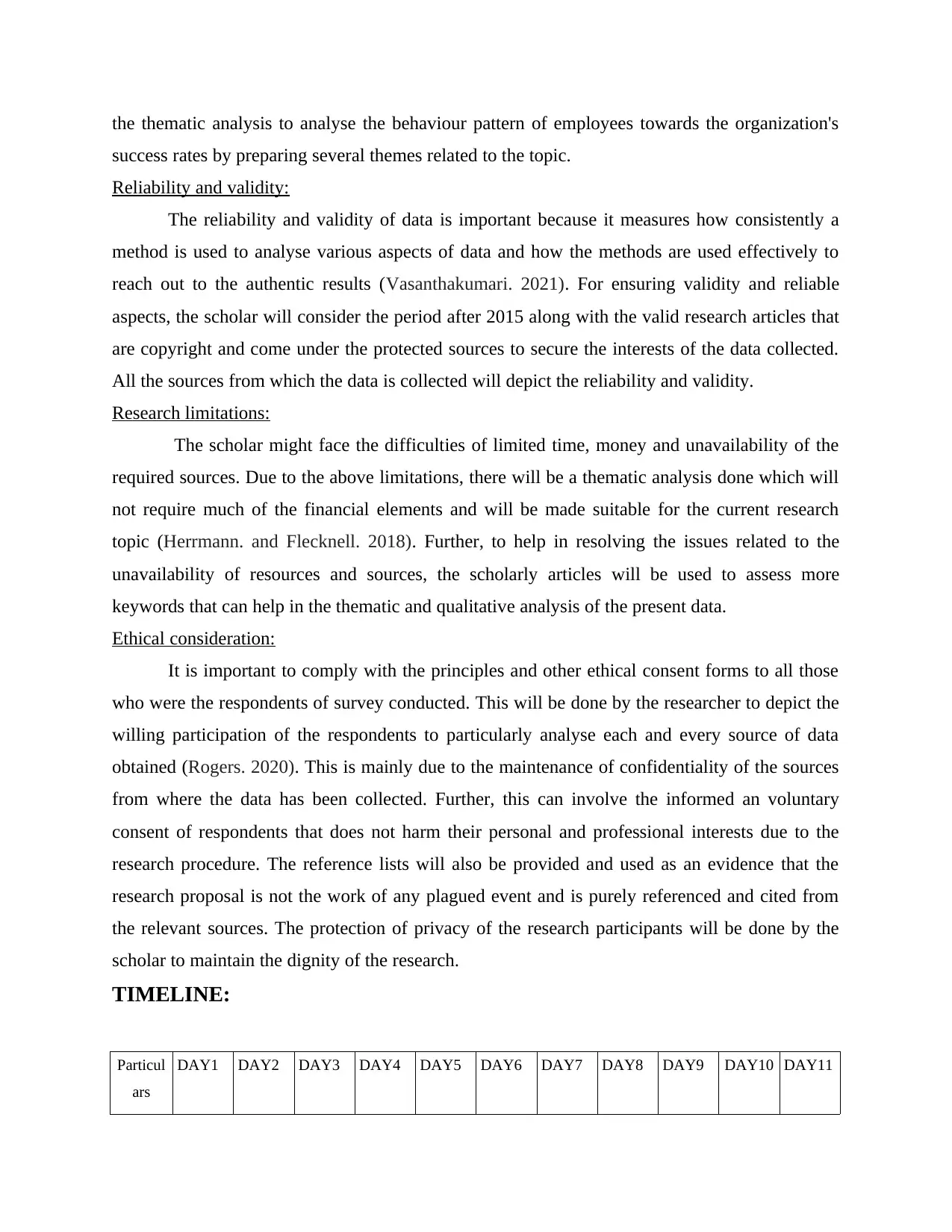
the thematic analysis to analyse the behaviour pattern of employees towards the organization's
success rates by preparing several themes related to the topic.
Reliability and validity:
The reliability and validity of data is important because it measures how consistently a
method is used to analyse various aspects of data and how the methods are used effectively to
reach out to the authentic results (Vasanthakumari. 2021). For ensuring validity and reliable
aspects, the scholar will consider the period after 2015 along with the valid research articles that
are copyright and come under the protected sources to secure the interests of the data collected.
All the sources from which the data is collected will depict the reliability and validity.
Research limitations:
The scholar might face the difficulties of limited time, money and unavailability of the
required sources. Due to the above limitations, there will be a thematic analysis done which will
not require much of the financial elements and will be made suitable for the current research
topic (Herrmann. and Flecknell. 2018). Further, to help in resolving the issues related to the
unavailability of resources and sources, the scholarly articles will be used to assess more
keywords that can help in the thematic and qualitative analysis of the present data.
Ethical consideration:
It is important to comply with the principles and other ethical consent forms to all those
who were the respondents of survey conducted. This will be done by the researcher to depict the
willing participation of the respondents to particularly analyse each and every source of data
obtained (Rogers. 2020). This is mainly due to the maintenance of confidentiality of the sources
from where the data has been collected. Further, this can involve the informed an voluntary
consent of respondents that does not harm their personal and professional interests due to the
research procedure. The reference lists will also be provided and used as an evidence that the
research proposal is not the work of any plagued event and is purely referenced and cited from
the relevant sources. The protection of privacy of the research participants will be done by the
scholar to maintain the dignity of the research.
TIMELINE:
Particul
ars
DAY1 DAY2 DAY3 DAY4 DAY5 DAY6 DAY7 DAY8 DAY9 DAY10 DAY11
success rates by preparing several themes related to the topic.
Reliability and validity:
The reliability and validity of data is important because it measures how consistently a
method is used to analyse various aspects of data and how the methods are used effectively to
reach out to the authentic results (Vasanthakumari. 2021). For ensuring validity and reliable
aspects, the scholar will consider the period after 2015 along with the valid research articles that
are copyright and come under the protected sources to secure the interests of the data collected.
All the sources from which the data is collected will depict the reliability and validity.
Research limitations:
The scholar might face the difficulties of limited time, money and unavailability of the
required sources. Due to the above limitations, there will be a thematic analysis done which will
not require much of the financial elements and will be made suitable for the current research
topic (Herrmann. and Flecknell. 2018). Further, to help in resolving the issues related to the
unavailability of resources and sources, the scholarly articles will be used to assess more
keywords that can help in the thematic and qualitative analysis of the present data.
Ethical consideration:
It is important to comply with the principles and other ethical consent forms to all those
who were the respondents of survey conducted. This will be done by the researcher to depict the
willing participation of the respondents to particularly analyse each and every source of data
obtained (Rogers. 2020). This is mainly due to the maintenance of confidentiality of the sources
from where the data has been collected. Further, this can involve the informed an voluntary
consent of respondents that does not harm their personal and professional interests due to the
research procedure. The reference lists will also be provided and used as an evidence that the
research proposal is not the work of any plagued event and is purely referenced and cited from
the relevant sources. The protection of privacy of the research participants will be done by the
scholar to maintain the dignity of the research.
TIMELINE:
Particul
ars
DAY1 DAY2 DAY3 DAY4 DAY5 DAY6 DAY7 DAY8 DAY9 DAY10 DAY11
⊘ This is a preview!⊘
Do you want full access?
Subscribe today to unlock all pages.

Trusted by 1+ million students worldwide
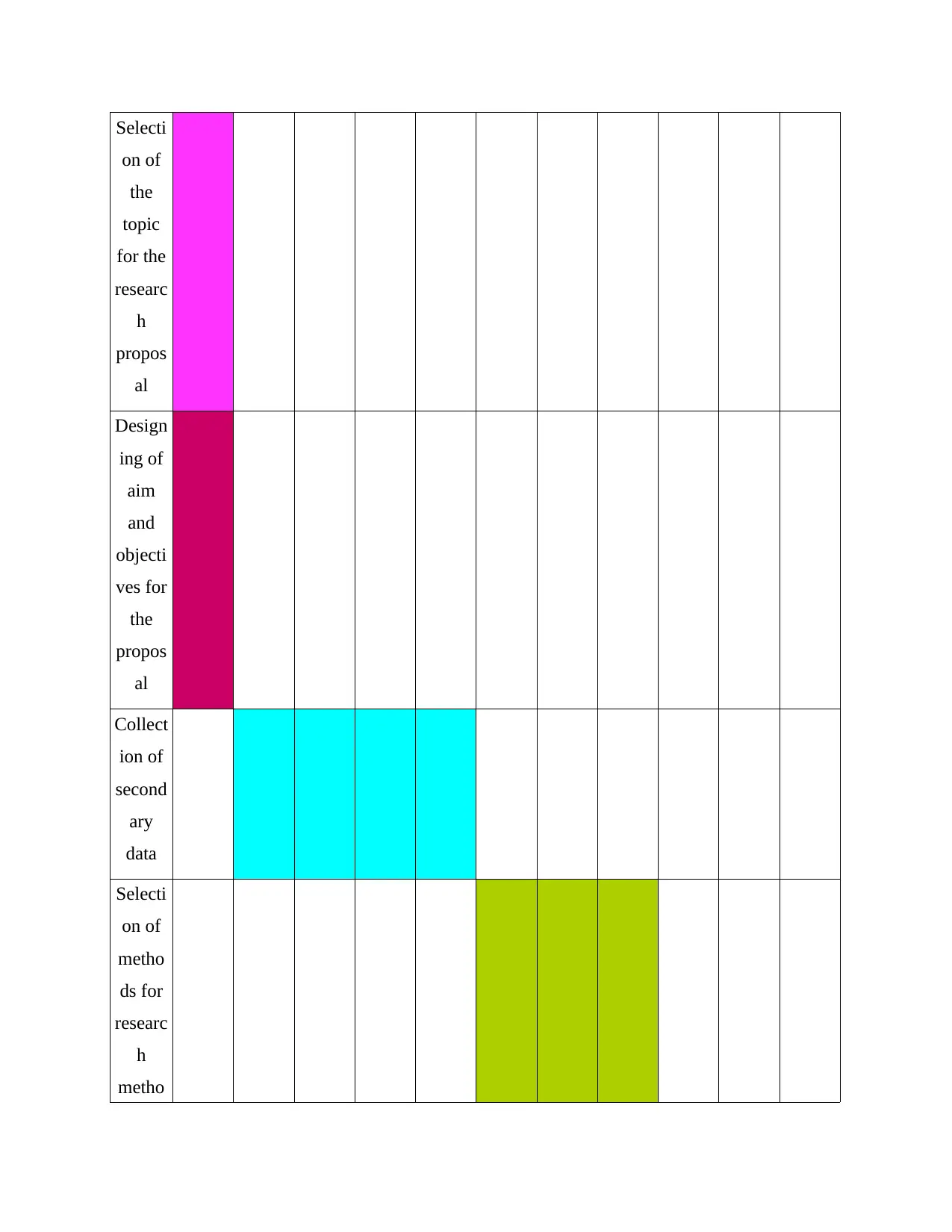
Selecti
on of
the
topic
for the
researc
h
propos
al
Design
ing of
aim
and
objecti
ves for
the
propos
al
Collect
ion of
second
ary
data
Selecti
on of
metho
ds for
researc
h
metho
on of
the
topic
for the
researc
h
propos
al
Design
ing of
aim
and
objecti
ves for
the
propos
al
Collect
ion of
second
ary
data
Selecti
on of
metho
ds for
researc
h
metho
Paraphrase This Document
Need a fresh take? Get an instant paraphrase of this document with our AI Paraphraser

dology
Format
ting of
the
propos
al
Submi
ssion
of the
propos
al
Waitin
g for
the
feedba
ck and
modifi
cations
Format
ting of
the
propos
al
Submi
ssion
of the
propos
al
Waitin
g for
the
feedba
ck and
modifi
cations
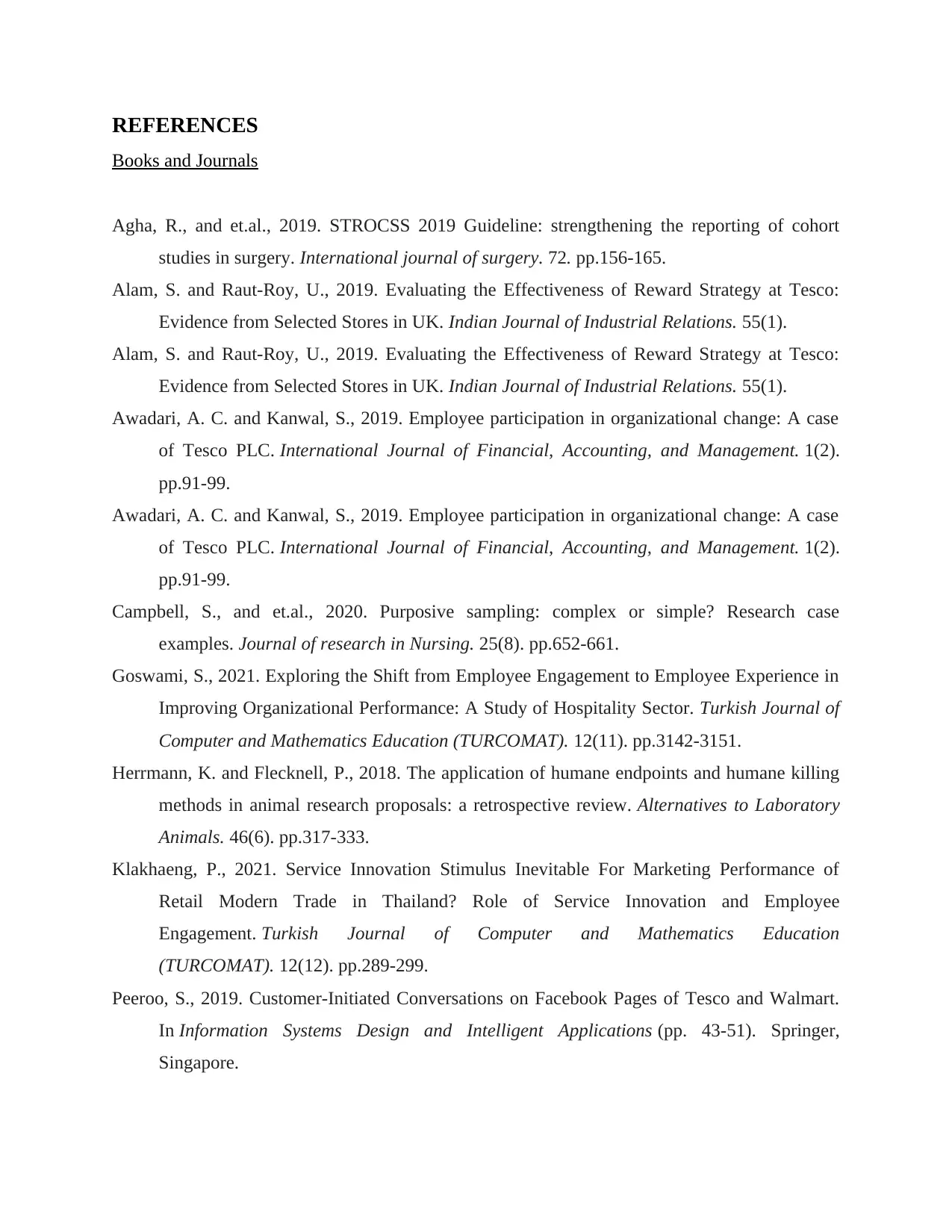
REFERENCES
Books and Journals
Agha, R., and et.al., 2019. STROCSS 2019 Guideline: strengthening the reporting of cohort
studies in surgery. International journal of surgery. 72. pp.156-165.
Alam, S. and Raut-Roy, U., 2019. Evaluating the Effectiveness of Reward Strategy at Tesco:
Evidence from Selected Stores in UK. Indian Journal of Industrial Relations. 55(1).
Alam, S. and Raut-Roy, U., 2019. Evaluating the Effectiveness of Reward Strategy at Tesco:
Evidence from Selected Stores in UK. Indian Journal of Industrial Relations. 55(1).
Awadari, A. C. and Kanwal, S., 2019. Employee participation in organizational change: A case
of Tesco PLC. International Journal of Financial, Accounting, and Management. 1(2).
pp.91-99.
Awadari, A. C. and Kanwal, S., 2019. Employee participation in organizational change: A case
of Tesco PLC. International Journal of Financial, Accounting, and Management. 1(2).
pp.91-99.
Campbell, S., and et.al., 2020. Purposive sampling: complex or simple? Research case
examples. Journal of research in Nursing. 25(8). pp.652-661.
Goswami, S., 2021. Exploring the Shift from Employee Engagement to Employee Experience in
Improving Organizational Performance: A Study of Hospitality Sector. Turkish Journal of
Computer and Mathematics Education (TURCOMAT). 12(11). pp.3142-3151.
Herrmann, K. and Flecknell, P., 2018. The application of humane endpoints and humane killing
methods in animal research proposals: a retrospective review. Alternatives to Laboratory
Animals. 46(6). pp.317-333.
Klakhaeng, P., 2021. Service Innovation Stimulus Inevitable For Marketing Performance of
Retail Modern Trade in Thailand? Role of Service Innovation and Employee
Engagement. Turkish Journal of Computer and Mathematics Education
(TURCOMAT). 12(12). pp.289-299.
Peeroo, S., 2019. Customer-Initiated Conversations on Facebook Pages of Tesco and Walmart.
In Information Systems Design and Intelligent Applications (pp. 43-51). Springer,
Singapore.
Books and Journals
Agha, R., and et.al., 2019. STROCSS 2019 Guideline: strengthening the reporting of cohort
studies in surgery. International journal of surgery. 72. pp.156-165.
Alam, S. and Raut-Roy, U., 2019. Evaluating the Effectiveness of Reward Strategy at Tesco:
Evidence from Selected Stores in UK. Indian Journal of Industrial Relations. 55(1).
Alam, S. and Raut-Roy, U., 2019. Evaluating the Effectiveness of Reward Strategy at Tesco:
Evidence from Selected Stores in UK. Indian Journal of Industrial Relations. 55(1).
Awadari, A. C. and Kanwal, S., 2019. Employee participation in organizational change: A case
of Tesco PLC. International Journal of Financial, Accounting, and Management. 1(2).
pp.91-99.
Awadari, A. C. and Kanwal, S., 2019. Employee participation in organizational change: A case
of Tesco PLC. International Journal of Financial, Accounting, and Management. 1(2).
pp.91-99.
Campbell, S., and et.al., 2020. Purposive sampling: complex or simple? Research case
examples. Journal of research in Nursing. 25(8). pp.652-661.
Goswami, S., 2021. Exploring the Shift from Employee Engagement to Employee Experience in
Improving Organizational Performance: A Study of Hospitality Sector. Turkish Journal of
Computer and Mathematics Education (TURCOMAT). 12(11). pp.3142-3151.
Herrmann, K. and Flecknell, P., 2018. The application of humane endpoints and humane killing
methods in animal research proposals: a retrospective review. Alternatives to Laboratory
Animals. 46(6). pp.317-333.
Klakhaeng, P., 2021. Service Innovation Stimulus Inevitable For Marketing Performance of
Retail Modern Trade in Thailand? Role of Service Innovation and Employee
Engagement. Turkish Journal of Computer and Mathematics Education
(TURCOMAT). 12(12). pp.289-299.
Peeroo, S., 2019. Customer-Initiated Conversations on Facebook Pages of Tesco and Walmart.
In Information Systems Design and Intelligent Applications (pp. 43-51). Springer,
Singapore.
⊘ This is a preview!⊘
Do you want full access?
Subscribe today to unlock all pages.

Trusted by 1+ million students worldwide
1 out of 13
Related Documents
Your All-in-One AI-Powered Toolkit for Academic Success.
+13062052269
info@desklib.com
Available 24*7 on WhatsApp / Email
![[object Object]](/_next/static/media/star-bottom.7253800d.svg)
Unlock your academic potential
Copyright © 2020–2025 A2Z Services. All Rights Reserved. Developed and managed by ZUCOL.





